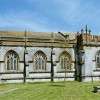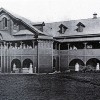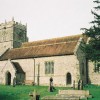In eastern Dorset, in the Cranborne Chase country near the Wilts and Hants border lies the barely registered hamlet of Chalbury. There has been a church here at least since the early 13th century, but one, which was never dedicated to any saint. It did not serve a community with a definitive nucleation around a green with cottages, shops, or an inn, but instead just a few dispersed dwellings clustered around the base of the low, though steep hill the church stands upon. But the building never underwent the development accretions that so many other churches in more prosperous parishes did.
This is clearly evident from the exterior appearance of Chalbury Church. To this day it remains a rustic memorial to a bygone society, way down on the scale of ecclesiastical architecture and appearing to show the hallmarks of a stagnant economy in the community it was built to minister to. This church still shows a simple nave – chancel plan, to which aisles, transepts or a tower were never added at a later stage. Instead the visitor is confronted by a long narrow building scarcely wider than a cottage, with only a south porch and a diminutive cubical bell-cote at the west end to summon the few faithful to worship through the tolling of its single bell.
Chalbury further departs from the customary appearance of churches in the more prosperous Dorset parishes by having a smooth whitewashed surface, as distinctive from the commonplace unadorned, frequently lichen-infested brick, stone and flint courses so evident elsewhere. Round-headed windows of only clear lights are set into the walls and the roof is of small, neat tiles, with a small skylight near the west end on the south side.
The appearance of the interior, as one might expect, is as unusual and unique as the outward aspect of this church. It is whitewashed, with a smooth corbelled ceiling below which some dark oak beams span the width of the nave. The original arch between the nave and chancel has been converted into a tripartite screen with a segmental-headed centre section with two straight-headed sections supported by classical columns on either side. It is several feet deep, so there is the effect of a short colonnade as well as screen.
This feature, as well as the interior details in general, is due to a re-ordering the church underwent in the 18th century, at which time also the original windows were replaced by the present ones. A further change of this century was the introduction of box pews, those on the south side being clearly some six inches than those on the north side. These pews reflect the status of their occupiers, and perhaps represent an apparent contradiction about Chalbury. It is a curious fact the the higher your status in the community, the higher the pew you occupied in church. In this instance the pews belonged to the tenant farmers of the parish, and may at first seem strange that these indicators of high social standing should be found in the church of such a small contracted community, instead of simple, crude benches.
But it is in the chancel that these higher social distinctions are even more apparent. On the south side there is a long seat reserved for the use of the Rector’s servants, but even more lavish is a balustraded and canopied pew, which was constructed for the Earl of Pembroke. A prominent triple-decked pulpit stands against the wall separating nave and chancel and embodies the great emphasise placed on the preaching of the word in the 19th century, But it is likely there were many more pews than worshippers to fill them.
Because definitive architectural features are rare, it is difficult to date the original building with certainty. The older parts are perhaps 13th century, while some extension was carried out in the 14th century. Then for four centuries any further development – at least in the form of structural alterations – at Chalbury was suspended. During this time it was one of a large number of English churches to be appropriated by a monastery, which appointed the rector. The monastery also had the right to the tithes in money and agricultural produce. Until the reformation and dissolution of the monasteries Chalbury was in the possession of St. Mary’s Abbey, twenty miles away at Wilton near Salisbury. The Earls of Pembroke became patrons of the living of Chalbury after Henry VIII sold possessions of St. Mary’s Abbey to the first Earl, William Herbert. The Earls had the right to appoint the rectors, but it is not known how often they occupied their pew, in the church.
The spacious churchyard has several large noble trees seeming to dwarf the low modest structure of the church. But the three hundred-foot hill on which it stands commands splendid views for miles around about which Hutchins commented: “A very high Elm tree standing by the church was used as a landmark because it could be seen from the Channel and might be plainly discerned from the hills that lie above Yarmouth in the Isle of Wight”. A storm in 1703 brought down the elm.
There are photos of Chalbury Church in the photo section



